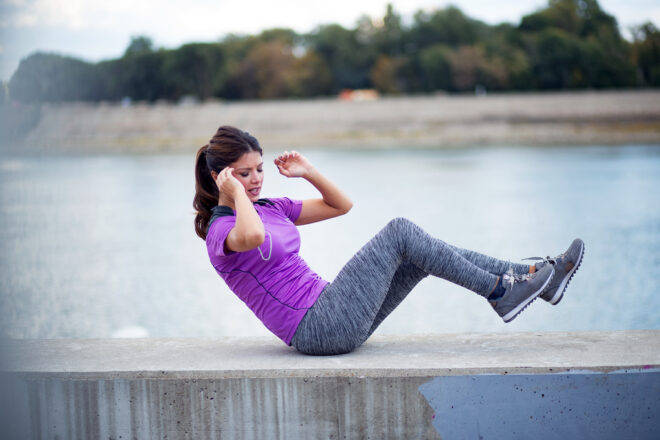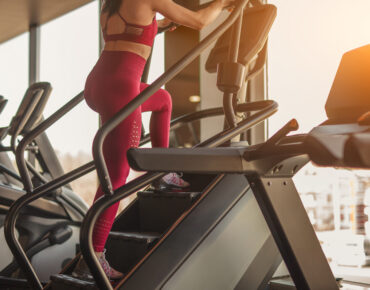What’s a crunch, if not one of the best exercises to help tone your abs? You’ve probably been crunching your abs at least once, but have you ever tried crunch kicks?
The purpose of a crunch kick exercise is to tone your lower abs and strengthen your core. It’s a simple bodyweight exercise you can do at home or while you’re traveling.
So, what are crunch kicks exactly? And how do you get them right?
Read on to find out what crunch kicks are, how they differ from kick-down crunches, and how to integrate them into your workout.
In This Article
In This Article:
Benefits of Crunch Kicks
It’s more than about your abs and core. Here are the key benefits you can get if you do crunch kicks every week.
Tone your abs
Crunch kicks can strengthen your abs and make your journey to a six-pack easier. But keep in mind that nutrition plays a crucial role in showcasing abs. More often than not, abs are made in the kitchen.
For your abs to show through, your body needs to have a certain percentage of body fat. Men need to be at 5–14% and women at 5–19% body fat.
Strengthen your core
From bending to tie your shoelaces to reaching out for a high object, a strong core makes everyday activities easier. It can also relieve back pain.
At the same time, it improves posture, stability and reduces the risk of injuries. It can help with maintaining a healthy running form too.
Improve flexibility
Crunch kicks can also help improve flexibility. As a runner, having higher flexibility can help you move with greater ease. It can lower your risk of injury too.
Burn calories
If you’re keen to burn some extra calories, crunch kicks can definitely help. After all, every calorie counts, right?
Boost your heart rate
Crunch kicks are demanding and will get your heart pumping right away.
Warm up
You can do crunch kicks as a warm-up exercise for your core, glutes, and legs. You can even incorporate them into a pre-run warm-up routine.
Focus Area: Muscles Worked
So, what muscles do crunches work? Crunch kicks work your lower abs, particularly the rectus abdominis muscle. This muscle lies between your pubic bone and ribs. The rectus abdominis enables the flexion of the trunk and helps with expiration too.
When it comes to crunches, muscles worked also include, to a lesser extent, the obliques and the deep core muscles.
As you may have guessed, your leg muscles get a bit of an exercise as well. Crunch kicks stimulate the glutes (hip muscles) and the quads (thigh muscles). It can warm up these muscles in preparation for a run or a more intense leg workout.
How to Do Crunch Kicks
You probably know how to do crunches already. Starting with your lower back and feet flat on the ground, you pull your body up by bringing your shoulders to your hips and engaging your stomach muscles. Keeping your core engaged, you then return to the starting position.
Doing crunch kicks is not much harder. Follow the simple steps below:
1. Lie down on the floor with your arms stretched at your sides. Your palms should be on the floor and slightly away from your body. Your shoulders should be slightly lifted.
2. Raise your feet off the floor and bend them at the knees.
3. Next, extend your knees away from your body.
4. Bring your knees back into the starting position to complete a rep.
5. As with standard crunches, do three sets of 10 to 12 reps.
Tip: An effective crunch kick workout includes other ab exercises, such as classic crunches, sit-ups, or lying knee raises. By incorporating crunch kicks with upper ab exercises, you can get a more fully defined ab.
Note: Don’t confuse crunch kicks with kick crunches. You do the latter standing up, touching your foot with your opposite hand as you bring it up.
Choosing Crunch Kick Variations
Crunch kicks are fun. But don’t forget that there are plenty of crunch variations you can try.
Note: For all these exercises, you can start with three sets of 10 to 12 reps.
Reverse crunches
What is a reverse crunch? Quite the opposite of a classic crunch, since you bring your knees to your chest rather than the other way around.
How to do reverse crunches
1. Lie on the floor with your arms stretched and palms down.
2. Raise your legs and bend your knees at a 90-degree angle. Your thighs should be perpendicular to the floor.
3. Engage your core and bring your knees to your chest, raising your hips off the floor.
4. Maintain the position for a moment.
5. Lower your legs back into the initial position.
As with all crunches, it’s better to do it slowly. Don’t rush it. Moving up with the swinging momentum from your legs is also one of the mistakes that should be avoided. Remember: it’s an ab exercise, not a swinging one!
Tabletop crunches
Tabletop crunches are a level up from standard crunches. But they’re not too hard to do, so you can try them if you’re in good shape.
How to do tabletop crunches
1. Lie on the floor.
2. Raise your legs and bend them at the knee at a right angle. Optionally, you can cross one foot over.
3. Place your hands on your head for support – no pulling!
4. Lift your upper body toward the knees to complete a crunch.
Twisting Crunches
This variation engages the side part of your ab muscles, the obliques.
How to do twisting crunches
1. Lie down with your knees bent and your feet on the floor.
2. Lift your back and shoulders off the floor as you would for a standard crunch.
3. Rotate your torso to one side.
4. Return to the starting position and repeat the movement, this time on the other side.
Avoiding Common Mistakes
As with any other workout, proper form is important when performing crunch kicks. So is breathing. Here are some common mistakes you want to avoid.
- Don’t breathe haphazardly. Mind your breathing pattern. Breathe in when you pull your legs in and breathe out when you extend them.
- Maintain proper form. Perform the exercise slowly enough for you to remain in control of it throughout. Don’t just follow the momentum of your movements.
- Fully straighten your legs when performing the kick.
- Keep your shoulders lifted off the ground and your arms stretched.
- Keep your knees close together as you bring them toward your face.
- When performing the kick, make sure your palms stay on the ground.
- Perform simple warm-ups before doing kick crunches.
Takeaways
Here are a few things to remember:
- Crunch kicks are an effective bodyweight abs exercise you can do every week.
- This exercise can tone your abs, strengthen your core, improve flexibility, and more.
- It’s best to integrate crunch kicks with other ab exercises for the best results.
- You won’t get a six-pack unless you also eat lean and achieve a low body fat percentage.
- Crunch kicks can be a good warm-up exercise for runners.
Add some crunch kicks to your next workout, and let us know how it goes!
Frequently Asked Questions
What are crunch kicks good for?
Crunch kicks are an effective bodyweight exercise for:
- Toning your lower abs: The alternating leg movement primarily targets the rectus abdominis muscle, particularly its lower portion.
- Strengthening your core: Engaging your core throughout the exercise helps stabilize your spine and improve overall core strength.
- Improving flexibility: The leg extensions and retractions can slightly enhance hip and lower back flexibility.
- Warming up: Crunch kicks can prepare your core for more demanding exercises in a workout routine.
Do crunches give you abs?
Crunches, including crunch kicks, can help strengthen and tone your abdominal muscles, but they alone won’t necessarily give you visible abs. Building visible abs requires two main factors:
- Reducing overall body fat: Abs are muscles under a layer of fat. To see them defined, you need to achieve a low body fat percentage, typically below 15% for men and 20% for women.
- Building overall core strength: Crunches target specific muscles, but a strong core involves various muscles, including obliques and transverse abdominis. Combining exercises targeting different core areas is crucial.
What is the best crunch movement?
There isn’t a single “best” crunch movement, as each variation targets different aspects of your core and might suit individual preferences and fitness levels better. Some popular crunch variations include:
- Standard crunches: These engage the upper and lower rectus abdominis.
- Reverse crunches: Focuses on the lower abs and hip flexors.
- Bicycle crunches: Targets obliques and upper abs with a twisting motion.
- Russian twists: Works obliques and core stability as you rotate your torso with a weight.
Are crunches worth it?
Crunches can be a valuable exercise as part of a comprehensive core workout routine, particularly for beginners. However, they have limitations:
- Potential for back pain: Improper form or overuse can strain your lower back. Focus on maintaining a neutral spine and engaging your core throughout the movement.
- Limited muscle engagement: Crunches primarily target the rectus abdominis, neglecting other crucial core muscles like obliques and transverse abdominis.
- Not the most effective for fat loss: Crunches primarily burn calories in the abdominal area, which isn’t the most efficient way to lose overall body fat.
Does crunch burn fat?
Like any exercise, crunches burn calories. However, they aren’t the most effective fat-burning exercise due to their targeted muscle group and limited calorie expenditure. Aim for compound exercises and cardio activities that engage larger muscle groups and elevate your heart rate for better fat burning results.
References
- Vagner, M., Cleather, D.J., Kubovy, P., Hojka, V. and Stastny, P., 2021. Effect of strength training programs on front push kick dynamics and kinematics. Archives of Budo.
- Sekendiz, B., Altun, Ö., Korkusuz, F. and Akın, S., 2007. Effects of Pilates exercise on trunk strength, endurance and flexibility in sedentary adult females. Journal of bodywork and movement therapies, 11(4), pp.318-326.
- Kim, S., Shim, J., Kim, S., Namkoong, S. and Kim, H., 2015. The effect of superficial trunk muscle exercise and deep trunk muscle exercise on the foot pressure of healthy adults. Journal of Physical Therapy Science, 27(3), pp.711-713.
- Brown, J., 2010. Build your own Abs: like anything else, sculpting an amazing midsection takes commitment, dedication and knowledge. We can help with that last part. Muscle & Fitness/Hers, 11(3), pp.52-58.
- Detz, J., 2005. Ultimate Core Ball Workout: Strengthening and Sculpting Exercises with Over 200 Step-by-Step Photos. Ulysses Press.














